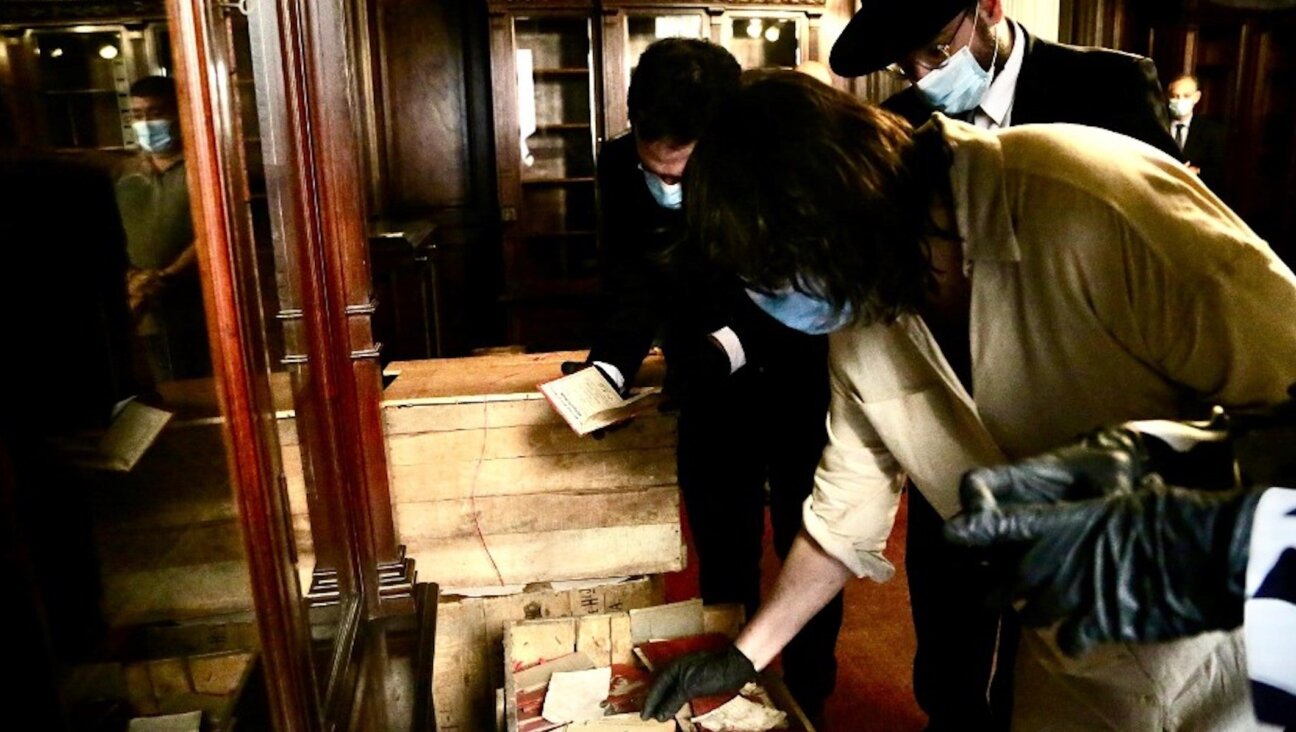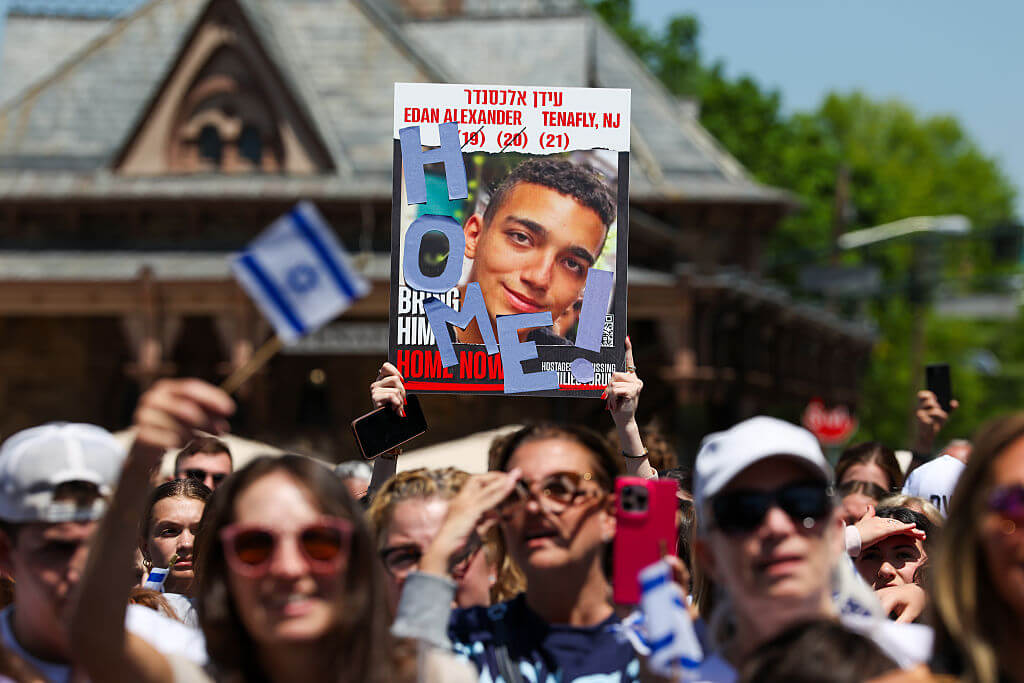Two-State Solution Still Alive and Kicking — in Congress at Least

Image by Getty Images
There’s a striking difference between competing bids in Congress addressing last month’s U.N. Security Council resolution condemning Israeli settlements.
It’s not that they differ on the United Nations – the two nonbinding congressional resolutions under consideration condemn the Security Council, as well as the outgoing Obama administration for abstaining and not exercising the U.S. veto.
Here’s the difference: Missing from one of the resolutions are the word “two states.” In the other resolution, the two-state outcome features prominently.
Sponsors said little on the record about the differences, but what the simultaneous introductions signal is a battle over whether it becomes U.S. policy to regard the two-state solution as dead or alive.
In one corner is the mainstream pro-Israel community, combining leftists and centrists and led by the American Israel Public Affairs Committee, seeking to preserve two states as a viable outcome for Israel and the Palestinians.
In the other is a deeply conservative and often Orthodox minority of the American Jewish community that includes figures who are close to President-elect Donald Trump. They want the two-state solution declared dead in order to pave the way for Israel to annex portions of the West Bank it still controls.
The winner in Round 1: AIPAC.
The Republican leadership of the incoming U.S. House of Representatives has scheduled a vote for Thursday on the resolution being backed by the lobby. Reps. Ed Royce, R-Calif., the chairman of the House Foreign Affairs Committee, and the committee’s senior Democrat, Rep. Eliot Engel, D-N.Y., are the sponsors.
The other resolution, brought out by Rep. Dennis Ross, R-Fla. — the House deputy majority whip and a member of Trump’s transition team — is in limbo awaiting consideration by the Foreign Affairs Committee.
The two-state outcome appears high in the Royce-Engel resolution, in the second paragraph: “Whereas the United States has long supported a negotiated settlement leading to a sustainable two-state solution with the democratic, Jewish state of Israel and a demilitarized, democratic Palestinian state living side-by-side in peace and security.”
That resolution calls on the United States to seek the repeal or alteration of the Security Council resolution, so that “it is no longer one-sided and anti-Israel.”
But don’t count out the other side. Trump has nominated as ambassador to Israel David Friedman, who has been a major donor to the settlement movement, and named as his top official dealing with international relations Jason Greenblatt, who has said that settlements are not an impediment to peace. The family of his son-in-law, Jared Kushner, has donated to settlements.
Additionally, the Republican Party, in a platform revision this summer, removed explicit references to two states. The Republican fund-raiser who helped engineer that change, Jeff Ballabon, told BuzzFeed News over the long weekend that now, within the GOP, “you have to justify the notion of a two-state solution.”
That might not be true yet, but the sponsors of the resolution competing with Royce’s is a who’s who of the party’s anti-establishment right wing. They have scored impressive wins in recent years, not least of which is backing the winning candidate for president.
While the resolution disapproves of the U.N. resolution and the Obama administration’s abstention, it does not refer to the two-state solution.
“Two states” was omitted, a Ross spokeswoman said, because the resolution was more narrowly focused.
“The resolution is a very narrow response to the U.N.’s vote, specifically condemning President Obama’s instruction to abstain and abandon our closest ally,” Joni Shockey told JTA.
Whereas the Royce resolution emphasizes backing Israel in its quest for peace, the Ross resolution stresses the alliance, saying that Congress “affirms its commitment to the State of Israel as our loyal friend and strong ally in the Middle East.”
Senate versions of each of the House resolutions are expected to be introduced in the coming days.
Rep. Eliot Engel, D-NY, attending a memorial vigil for victims of the Paris terror attack at the Riverdale Monument in the Bronx neighborhood in New York City, Nov. 15, 2015. (Eugene Gologursky/Getty Images) Rep. Eliot Engel attending a memorial vigil for victims of the Paris terror attack in the Bronx neighborhood of New York City, Nov. 15, 2015. (Eugene Gologursky/Getty Images) Ballabon told JTA that the Ross resolution made more sense, as it focused directly on the U.N. Security Council Resolution 2334.
“Instead of focusing on the real crime of 2334 — its abandonment of Israel and its legitimization of ethnic cleansing of Jews from the Jewish homeland — Royce’s resolution laments the damage to the ‘Two-State Solution’ – the fetishized fantasy of a peaceful PLO state,” he wrote JTA in an email.
U.S. administrations, Democratic and Republican, have embraced a two-state outcome since the early 2000s. It was the solution sought by President Bill Clinton at Camp David in 2000, and although George W. Bush seemed at first skeptical, he embraced the outcome by 2002.
Three rounds of failed peace talks under Clinton, then Bush, then Obama have dampened expectations that the outcome is set to arrive anytime soon.
Whether the “two state is dead” crowd wins the bigger game depends on an overcoming a number of formidable obstacles. Congressional leaders, even in this most polarizing of eras, still seek bipartisanship.
Whatever the tensions between Israeli Prime Minister Benjamin Netanyahu and President Barack Obama in recent years, congressional Democrats have shown they favor pro-Israel resolutions as long as they endorse two states. And Republican leaders like Royce and Rep. Kevin McCarthy, R-Calif., the majority leader who announced Thursday’s vote, will always be willing to tweak language to get the overwhelming majorities that show they are bridge builders.
Additionally, AIPAC’s role in this signifies the importance that the American Jewish establishment still attaches to a two-state outcome.
“Simply calling for a demilitarized and democratic Palestinian state living side by side in peace and harmony with Israel doesn’t necessarily translate into enduring reality,” American Jewish Committee CEO David Harris told JTA. “We’re talking about the Middle East, after all. But given the weak alternatives, this approach still seems the most feasible, particularly if Israel’s Jewish and democratic character are to be preserved for future generations.”
Then there’s Netanyahu, who still embraces the notion of two states, however much his party and governing coalition have abandoned the policy.
David Makovsky, a fellow at the Washington Institute for Near East Policy, said Netanyahu may encourage the Trump administration to preserve two states as an outcome by reviving President George W. Bush’s 2004 approach. In an April 14, 2004 letter to then-Prime Minister Ariel Sharon, Bush essentially recognized settlement blocs bordering the 1967 lines as likely to remain in Israel, and opposed expansion of settlements beyond the security fence now bisecting the West bank.
“A reaffirmation of the Bush letter would help establish U.S. policy at a time when a U.S. administration will be preoccupied with other more urgent priorities,” said Makovsky, who was a member of the State Department team that last tried to broker an Israeli-Palestinian peace in 2013-14. “This would be convenient for Netanyahu and Trump and would retain the viability of two states.”
Why would Trump defy his closest Jewish advisers and continue to bank on a two-state outcome? Trump has proven unpredictable. He said several times while campaigning that he would like to take a stab at this most knotty of American foreign policy challenges.
And the AJC’s Harris and Makovksy, in separate interviews, cited another factor in the president-elect’s biography: He can’t resist the challenge of a deal that has so far defeated all comers.
“He’s a lifelong deal maker,” Harris said of the author of the best-selling “The Art of the Deal.” “This one may at some point tempt him as the ultimate challenge.”
The Forward is free to read, but it isn’t free to produce

I hope you appreciated this article. Before you go, I’d like to ask you to please support the Forward.
Now more than ever, American Jews need independent news they can trust, with reporting driven by truth, not ideology. We serve you, not any ideological agenda.
At a time when other newsrooms are closing or cutting back, the Forward has removed its paywall and invested additional resources to report on the ground from Israel and around the U.S. on the impact of the war, rising antisemitism and polarized discourse.
This is a great time to support independent Jewish journalism you rely on. Make a gift today!
— Rachel Fishman Feddersen, Publisher and CEO
Support our mission to tell the Jewish story fully and fairly.
Most Popular
- 1

Fast Forward Ye debuts ‘Heil Hitler’ music video that includes a sample of a Hitler speech
- 2

Opinion It looks like Israel totally underestimated Trump
- 3

Culture Is Pope Leo Jewish? Ask his distant cousins — like me
- 4

Fast Forward Student suspended for ‘F— the Jews’ video defends himself on antisemitic podcast
In Case You Missed It
-

Fast Forward For the first time since Henry VIII created the role, a Jew will helm Hebrew studies at Cambridge
-

Fast Forward Argentine Supreme Court discovers over 80 boxes of forgotten Nazi documents
-

News In Edan Alexander’s hometown in New Jersey, months of fear and anguish give way to joy and relief
-

Fast Forward What’s next for suspended student who posted ‘F— the Jews’ video? An alt-right media tour
-
Shop the Forward Store
100% of profits support our journalism
Republish This Story
Please read before republishing
We’re happy to make this story available to republish for free, unless it originated with JTA, Haaretz or another publication (as indicated on the article) and as long as you follow our guidelines.
You must comply with the following:
- Credit the Forward
- Retain our pixel
- Preserve our canonical link in Google search
- Add a noindex tag in Google search
See our full guidelines for more information, and this guide for detail about canonical URLs.
To republish, copy the HTML by clicking on the yellow button to the right; it includes our tracking pixel, all paragraph styles and hyperlinks, the author byline and credit to the Forward. It does not include images; to avoid copyright violations, you must add them manually, following our guidelines. Please email us at [email protected], subject line “republish,” with any questions or to let us know what stories you’re picking up.












